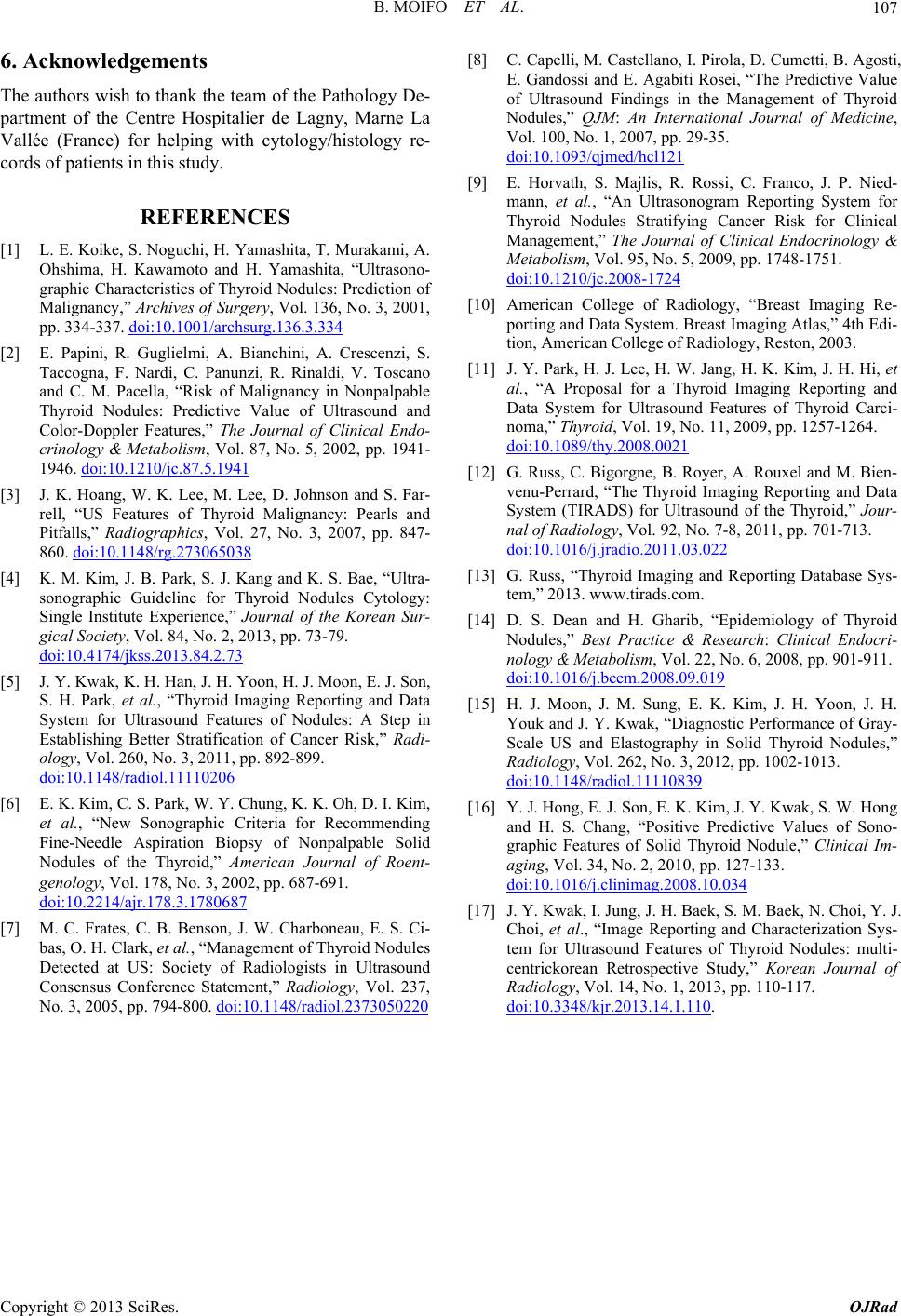
B. MOIFO ET AL.
Copyright © 2013 SciRes. OJRad
107
6. Acknowledgements
The authors wish to thank the tea m of the Patho logy De-
partment of the Centre Hospitalier de Lagny, Marne La
Vallée (France) for helping with cytology/histology re-
cords of patients in this study.
REFERENCES
[1] L. E. Koike, S. Noguchi, H. Yamashita, T. Murakami, A.
Ohshima, H. Kawamoto and H. Yamashita, “Ultrasono-
graphic Characteristics of Thyroid Nodules: Prediction of
Malignancy,” Archives of Surgery, Vol. 136, No. 3, 2001,
pp. 334-337. doi:10.1001/archsurg.136.3.334
[2] E. Papini, R. Guglielmi, A. Bianchini, A. Crescenzi, S.
Taccogna, F. Nardi, C. Panunzi, R. Rinaldi, V. Toscano
and C. M. Pacella, “Risk of Malignancy in Nonpalpable
Thyroid Nodules: Predictive Value of Ultrasound and
Color-Doppler Features,” The Journal of Clinical Endo-
crinology & Metabolism, Vol. 87, No. 5, 2002, pp. 1941-
1946. doi:10.1210/jc.87.5.1941
[3] J. K. Hoang, W. K. Lee, M. Lee, D. Johnson and S. Far-
rell, “US Features of Thyroid Malignancy: Pearls and
Pitfalls,” Radiographics, Vol. 27, No. 3, 2007, pp. 847-
860. doi:10.1148/rg.273065038
[4] K. M. Kim, J. B. Park, S. J. Kang and K. S. Bae, “Ultra-
sonographic Guideline for Thyroid Nodules Cytology:
Single Institute Experience,” Journal of the Korean Sur-
gical Society , Vol. 84, No. 2, 2013, pp. 73-79.
doi:10.4174/jkss.2013.84.2.73
[5] J. Y. Kwak, K. H. Han, J. H. Yoon, H. J. Moon, E. J. Son,
S. H. Park, et al., “Thyroid Imaging Reporting and Data
System for Ultrasound Features of Nodules: A Step in
Establishing Better Stratification of Cancer Risk,” Radi-
ology, Vol. 260, No. 3, 2011, pp. 892-899.
doi:10.1148/radiol.11110206
[6] E. K. Kim, C. S. Park, W. Y. Chung, K. K. Oh, D. I. Kim,
et al., “New Sonographic Criteria for Recommending
Fine-Needle Aspiration Biopsy of Nonpalpable Solid
Nodules of the Thyroid,” American Journal of Roent-
genology, Vol. 178, No. 3, 2002, pp. 687-691.
doi:10.2214/ajr.178.3.1780687
[7] M. C. Frates, C. B. Benson, J. W. Charboneau, E. S. Ci-
bas, O. H. Clark, et al., “Management of Thyroid Nodules
Detected at US: Society of Radiologists in Ultrasound
Consensus Conference Statement,” Radiology, Vol. 237,
No. 3, 2005, pp. 794-800. doi:10.1148/radiol.2373050220
[8] C. Capelli, M. Castella no, I. Pirola, D. Cume tti, B. Agosti,
E. Gandossi and E. Agabiti Rosei, “The Predictive Value
of Ultrasound Findings in the Management of Thyroid
Nodules,” QJM: An International Journal of Medicine,
Vol. 100, No. 1, 2007, pp. 29-35.
doi:10.1093/qjmed/hcl121
[9] E. Horvath, S. Majlis, R. Rossi, C. Franco, J. P. Nied-
mann, et al., “An Ultrasonogram Reporting System for
Thyroid Nodules Stratifying Cancer Risk for Clinical
Management,” The Journal of Clinical Endocrinology &
Metabolism, Vol. 95, No. 5, 2009, pp. 1748-1751.
doi:10.1210/jc.2008-1724
[10] American College of Radiology, “Breast Imaging Re-
porting and Data System. Breast Imaging Atlas,” 4th Edi-
tion, American College of Radiology, Reston, 2003.
[11] J. Y. Park, H. J. Lee, H. W. Jang, H. K. Kim, J. H. Hi, et
al., “A Proposal for a Thyroid Imaging Reporting and
Data System for Ultrasound Features of Thyroid Carci-
noma,” Thyroid, Vol. 19, No. 11, 2009, pp. 1257-1264.
doi:10.1089/thy.2008.0021
[12] G. Russ, C. Bigorgne, B. Royer, A. Rouxel and M. Bien-
venu-Perrard, “The Thyroid Imaging Reporting and Data
System (TIRADS) for Ultrasound of the Thyroid,” Jour-
nal of Radiology, Vol. 92, No. 7-8, 2011, pp. 701-713.
doi:10.1016/j.jradio.2011.03.022
[13] G. Russ, “Thyroid Imaging and Reporting Database Sys-
tem,” 2013. www.tirads.com.
[14] D. S. Dean and H. Gharib, “Epidemiology of Thyroid
Nodules,” Best Practice & Research: Clinical Endocri-
nology & Metabolism, Vol. 22, No. 6, 2008, pp. 901-911.
doi:10.1016/j.beem.2008.09.019
[15] H. J. Moon, J. M. Sung, E. K. Kim, J. H. Yoon, J. H.
Youk and J. Y. Kwak, “Diagnostic Performance of Gray-
Scale US and Elastography in Solid Thyroid Nodules,”
Radiology, Vol. 262, No. 3, 2012, pp. 1002-1013.
doi:10.1148/radiol.11110839
[16] Y. J. Hong, E. J. Son, E. K. Kim, J. Y. Kwak, S. W. Hong
and H. S. Chang, “Positive Predictive Values of Sono-
graphic Features of Solid Thyroid Nodule,” Clinical Im-
aging, Vol. 34, No. 2, 2010, pp. 127-133.
doi:10.1016/j.clinimag.2008.10.034
[17] J. Y. Kwak, I. Jung, J. H. Baek, S. M. Baek, N. Choi, Y. J.
Choi, et al., “Image Reporting and Characterization Sys-
tem for Ultrasound Features of Thyroid Nodules: multi-
centrickorean Retrospective Study,” Korean Journal of
Radiology, Vol. 14, No. 1, 2013, pp. 110-117.
doi:10.3348/kjr.2013.14.1.110.